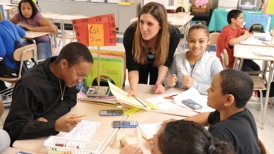
 Meanwhile, across the Atlantic (in Finland) children were excelling. Why? Because teachers were encouraged to be innovative, money was provided for public education and students were allowed to enjoy themselves, to learn things together and independently. They have been given the freedom to learn, without excessive homework and standardized testing.
Children are natural born learners- curious, sociable, skillful, joyful, compassionate and creative by nature. Their minds are open and flexible, their hearts trusting and generous. They come into the world with brains designed to learn from their local environment, to interact skillfully with the people and objects that surround them.
Meanwhile, across the Atlantic (in Finland) children were excelling. Why? Because teachers were encouraged to be innovative, money was provided for public education and students were allowed to enjoy themselves, to learn things together and independently. They have been given the freedom to learn, without excessive homework and standardized testing.
Children are natural born learners- curious, sociable, skillful, joyful, compassionate and creative by nature. Their minds are open and flexible, their hearts trusting and generous. They come into the world with brains designed to learn from their local environment, to interact skillfully with the people and objects that surround them.They enjoy experimenting with new things and investigating whatever interests them. They learn languages and gain new skills easily, as long as they are respected, assisted (when needed) and encouraged to enjoy the learning process.
Maria Montessori understood this, and taught that the role of educators is to organize learning environments so that they facilitate self-discovery, creativity, concentration and collaborative exploration.
 Put another way, children learn best when learning is playful, social, interesting and self-directed. There is no need for constant control, monitoring, external rewards and punishments. In fact, such authoritarian efforts tend to deter children’s learning, deaden their natural motivation and curiosity.
Put another way, children learn best when learning is playful, social, interesting and self-directed. There is no need for constant control, monitoring, external rewards and punishments. In fact, such authoritarian efforts tend to deter children’s learning, deaden their natural motivation and curiosity.
Young people enjoy learning when it is meaningful and collaborative. They will put time and effort into mastering skills and helping one another. They have a natural desire to communicate, to be creative, competent, sociable and successful.
 Adults have an important role to play with this, but attempts to over-control the natural learning process will immediately begin to snuff it out. Rigid expectations, testing and comparisons are also harmful, as no two children will learn in the exact same way or at the same rate.
Adults have an important role to play with this, but attempts to over-control the natural learning process will immediately begin to snuff it out. Rigid expectations, testing and comparisons are also harmful, as no two children will learn in the exact same way or at the same rate.
Adults need to be good role models and provide extra help for those who are struggling, but this should be done with love, respect and good intentions. Bottom line, children lose interest when adults are too rigid, demanding and controlling. Such learning experiences become miseducative, as John Dewey put it.
The bottom line, children need to be free to learn.
Related:
* How Wisdom Grows – Educating Hearts & Minds * Understanding How Our Brains Learn * Toward a More Creative & Holistic Model of Education * Video on Montessori Schools * Every Child is an Artist by Nature * Flow- the Psychology of Optimal Experience * The Mastery Process: How Our Skills Grow * Self-direction is the Key to Mastery * Invest in Children, Not Testing. It’s That Simple. * Symphonic Intelligence: The Next Revolution in Learning? * How We Participate in the Creative Life of the Universe * Real Learning is a Creative Process * Educational Malpractice – The Child Manufacturing Process *

Pingback: The Joy of Learning | I can explain it to you, ...
Exactly so – what we do now is train them to be automatons, rarely daring to question civil, military or ecclesiastical authority. That is how we brought forth and sustain the current pack of governors, legislators and contenders for high office.
So very interested in all about éducation as growing into a réal humain being, would appréciateur exchanging views ..
So very interested in all about éducation as growing into a réal humain being, would appréciateur exchanging views ..
More directly and openly
It is so refreshing to know that there are others out there that have the same beliefs that I have about how children should be encouraged and thereby how they learn. As a retired elementary teacher, my classrooms were filled with hands-on centers full of art, writing, and reading, plus Legos, clay, paint, etc. I used the beautiful illustrations from children’s literature as my guide. We had fun and we learned. It was a wonderful experience until No Child Left Behind was introduced and all the fun was taken out. Good for you Chirstopher Chase.
Thanks Laray. Yes, things were going so well in the 1990s, we need to get back to that!!
Pingback: What Makes Learning Enjoyable–in Children? – The Joy of Learning